Introduction
Aeration
tanks (AT) are widely used in practice for biological wastewater
treatment at treatment plants. AT are used for industrial or
municipal wastewaters treatment and may work under dif-ferent
regimes. There are different types of AT but in practice so called
«vitesnitel»
AT (AT of displacement type) is often used: In this AT influent
(waste waters) and sludge, which is used for biological treatment,
are supplied at one side of the AT (inlet boundary) and are
discharged at the opposite side (outlet boundary) (Fig.1).

Fig.
1. Aeration tank «vitesnitel»
(AT
of displacement type)
Literature
review
Mathematical
models which are used for aeration tank calculation can be separated
in some classes. First of all we have to mention empirical mo-dels
which were built on the basis of physical experiments [5, 7]. These
models have the form of simple algebraic formulae with some
empirical coefficients. These models are widely used in Ukraine but
for calculation of typical AT and for the typical regimes of work
for which the empirical constants were obtained. We can’t use
these mo-dels for scientific research, for example, to predict the
output parameters after treatment in the case which is out of the
normal work of aeration tank.
The
second class of the models includes mass balance models. These
models can be named «zero-dimentional» models. The balance models
are very popular [3, 4, 8, 17] and take into account some important
parameters of aeration tank work. These models are based on the
ordinary differential equations which represent mass balance of
sludge, admixture or oxygen in aeration tank. These diffe-rential
equations can be solved analytically or numerically (for example
using Runge – Kutte me-thod).
Some commercial codes can be used to perform calculations on the
basis of these models. These models are very convenient for
prediction of aeration tank output parameters but the models do not
take into account the fluid dynamics process in AT.
The
models of the third class are based on «one–dimentional»
equations of mass transport to simulate, for example, substrate
dispersion in AT [6, 9]. The modeling equations are solved
analytically. Fluid dynamics is taken into account in these models
but for the case of constant velocity in AT.
CFD
models are the most «powerful» models at present time to solve the
problems of wastewater treatment [1, 2, 10, 12-15]. These models can
reproduce the flow field in the AT and admixture transfer for
different regimes of work with account of AT geometrical form. As a
rule the CFD expe-riments are performed using commercial codes (for
example, ANSYS, Fluent) [11, 12, 16, 17]. CFD experiments comprise
of two steps. The first step is computation of flow field. Very
often this flow field is computed using of Navier – Stokes
equations. The second step is simulation of admixture transfer on
the basis of computed flow field. Application of Navier-Stokes
equations needs much computing time (to solve some problems it may
take from 90h to some weeks to perform CFD experiment). It is not
convenient in case of many calculations during AT design or at stage
of AT re-engineering.
Purpose
The
purpose of this work is the development of quick-computing numerical
model to simulate the process of biological wastewater treatment in
«vitesnitel»
aeration tank (aeration tank of displacement type).
Mathematical
model
To
simulate the process of biological treatment in AT, at each time
step of mathematical simulation, we separate the process in two
stages. At first stage we consider the process of substrate and
sludge movement in the aeration tank. It is so called «mass
transfer» process. To simulate this process we use the following
2-D transport equations (plan model) [7, 12]:
 (1)
(1)
 (2)
(2)
where
 – is the averaged concentration of substrate; H – is the depth
– is the averaged concentration of substrate; H – is the depth
of the aeration tank (Fig.1);
 – is the averaged concentration of
sludge for biological treatment;
– is the averaged concentration of
sludge for biological treatment;
 – are the flow velocity components in x,
y direction respectively;
– are the flow velocity components in x,
y direction respectively;
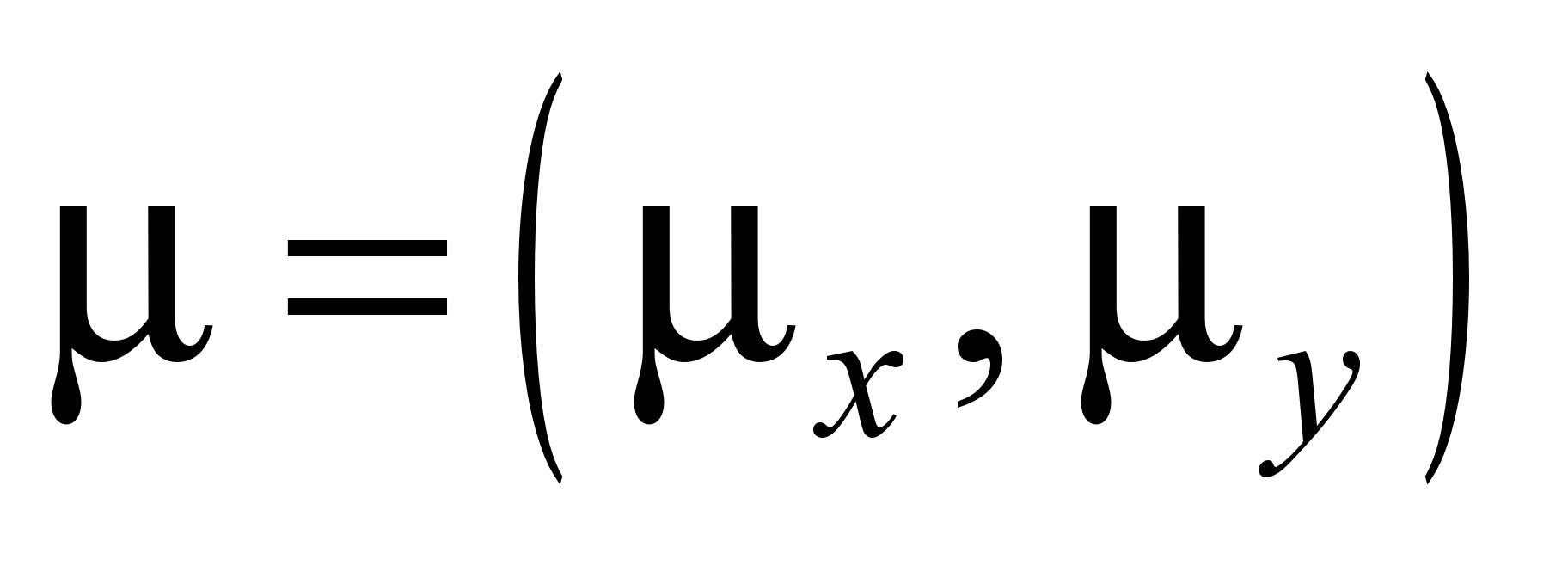 – are the
coefficients of turbulent diffusion in x,
y direction respectively;
– are the
coefficients of turbulent diffusion in x,
y direction respectively;
 – is time.
– is time.
The
boundary conditions for these equations are as following:
at
the inlet opening the boundary condition is
 (3)
(3)
where
 are known concentrations of substrate and sludge respectively.
are known concentrations of substrate and sludge respectively.
2. at
the outlet opening the boundary condition in the numerical model
(Fig.2) is written as follows
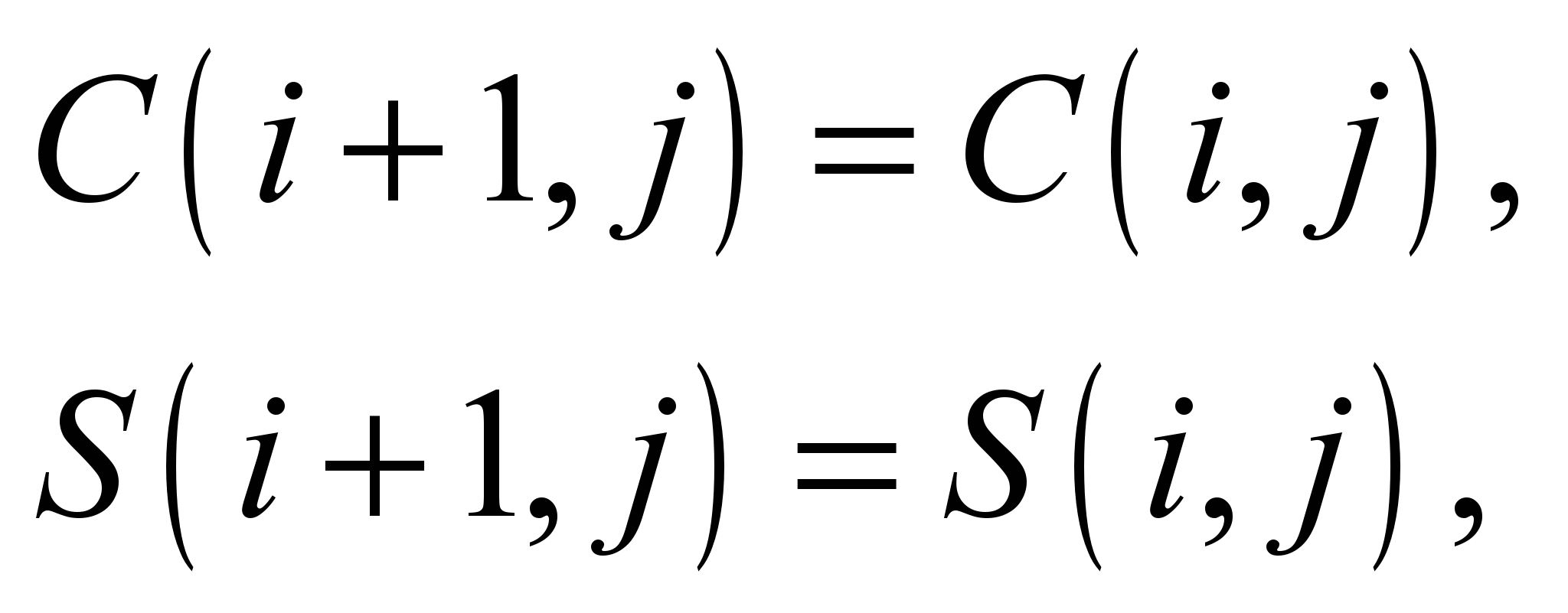 (4)
(4)
where
 are concentrations at the last computational cell;
are concentrations at the last computational cell;
 are concentrations at the previous computational cell.
are concentrations at the previous computational cell.
Boundary
condition (4) means that we neglect the diffusion process at the
outlet boundary.

Fig.
2. Sketch of computational domain
at
the solid walls the boundary condition is
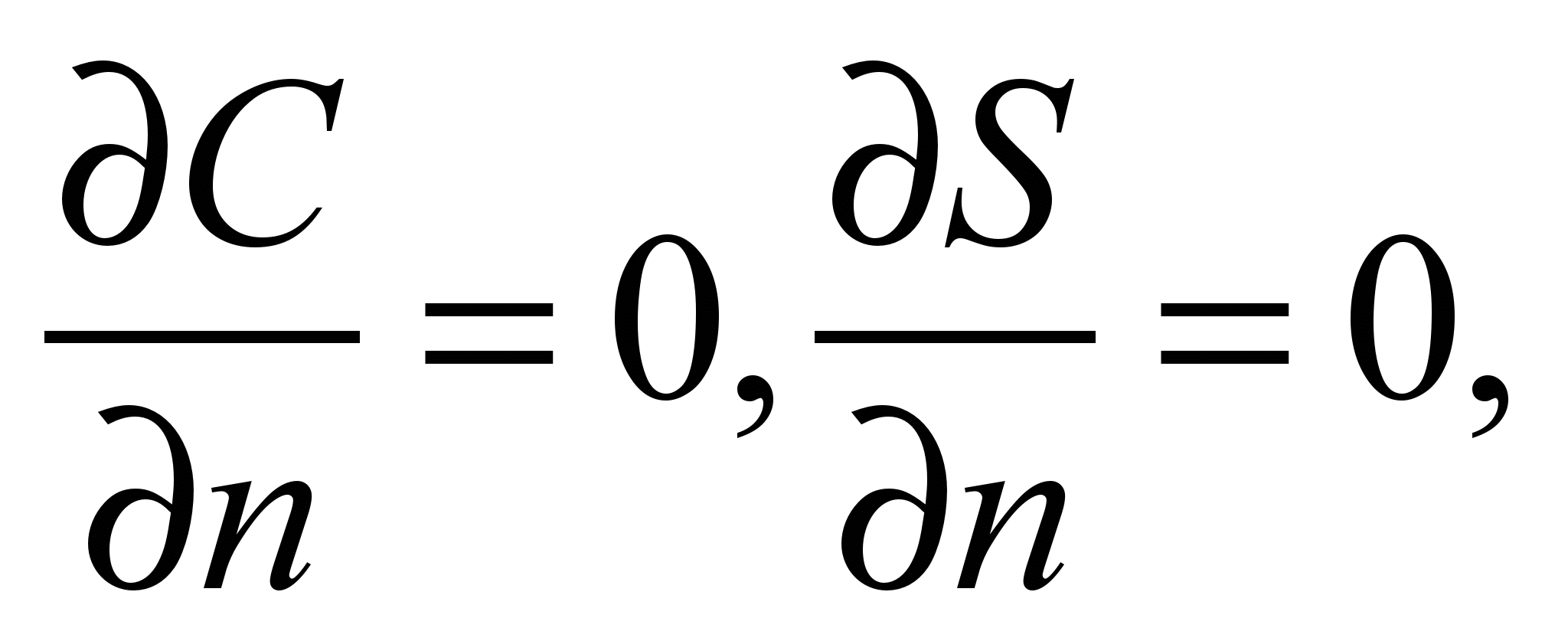
where
 is normal vector to the boundary.
is normal vector to the boundary.
The
initial condition, for
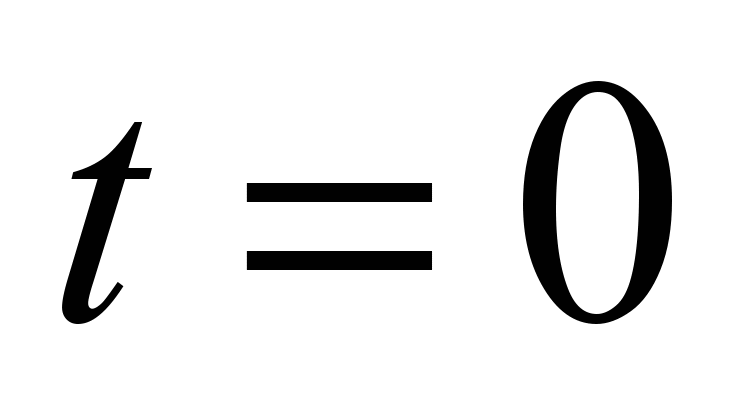 ,
is
,
is

where
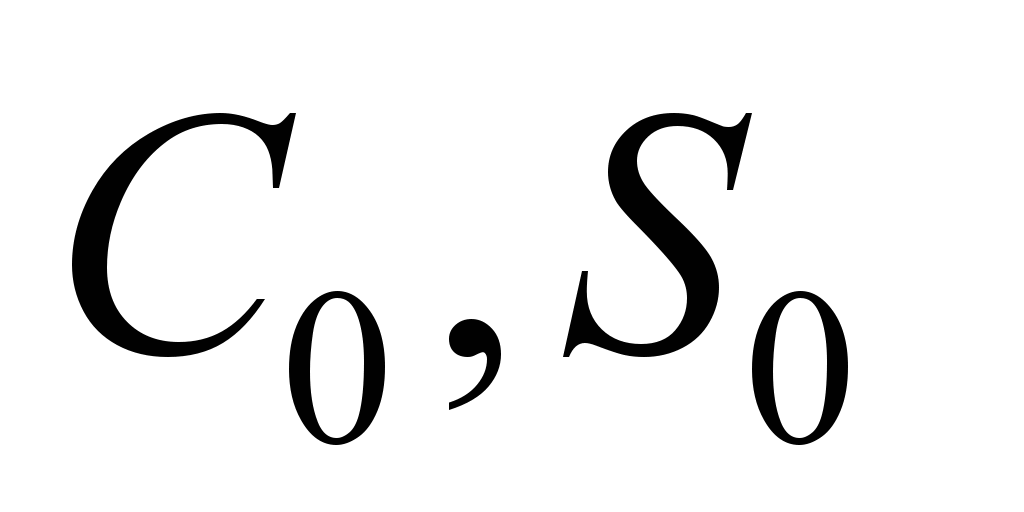 are known concentrations of substrate and sludge respectively in
computational domain.
are known concentrations of substrate and sludge respectively in
computational domain.
At
the second stage of mathematical simulation we consider the
biological process in the aeration tank. To simulate this process in
each computational cell inside the aeration tank we use the
following simplified model
 , (5)
, (5)
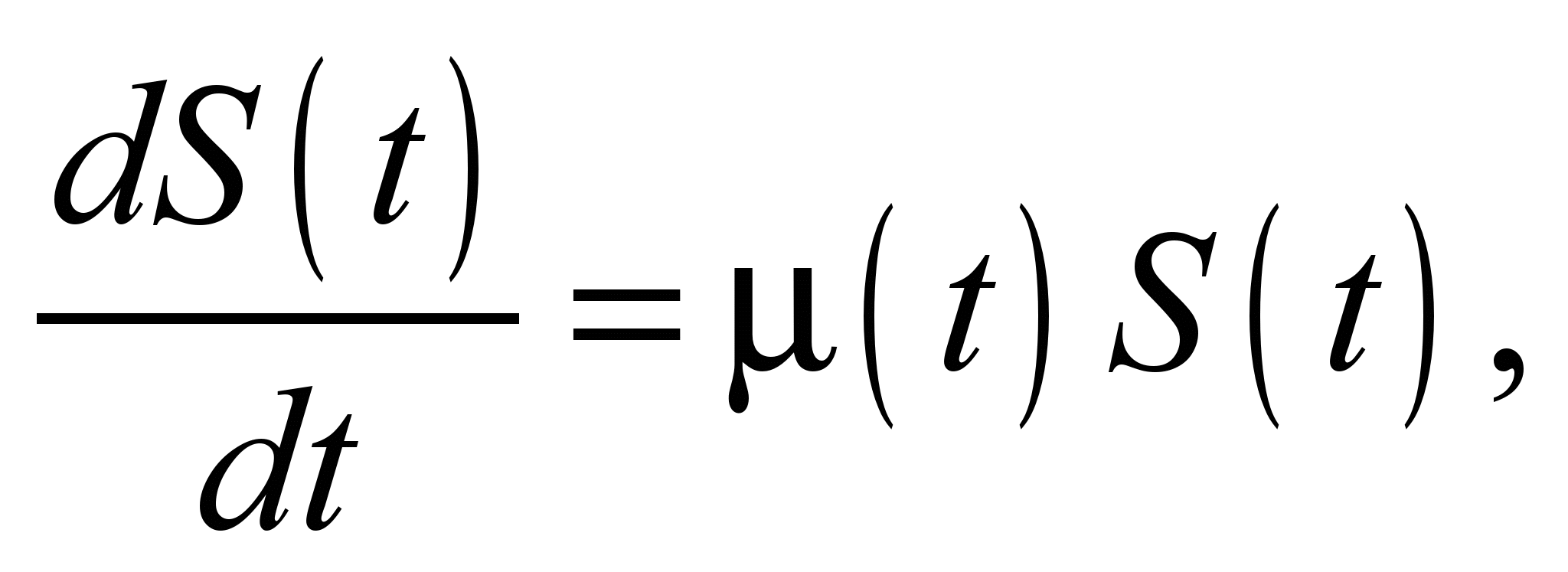 (6)
(6)
where
 is biomass growth rate;
is biomass growth rate;
 is biomass yield factor.
is biomass yield factor.
To
calculate biomass growth rate Monod law is used.
As
the initial condition for each equation (5), (6), at each time step,
we use the meaning of C, S obtained after computing Eq. 1, 2.
To
solve Eq.1, 2 it is necessary to know the flow field in aeration
tank. To simulate this flow field we use model of potential flow. In
this case the governing equation is
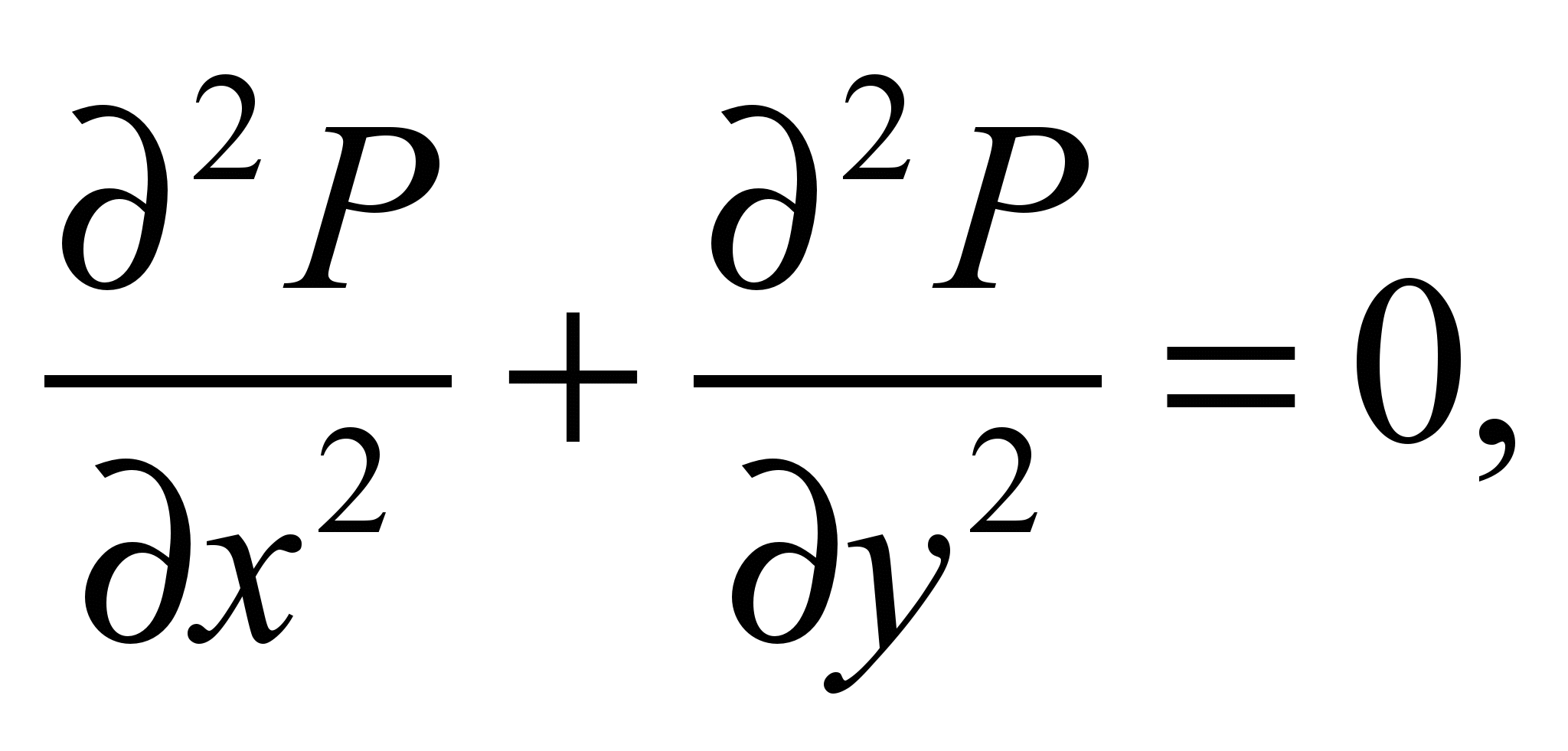 (7)
(7)
where Р
is the potential of velocity.
The
velocity components are calculated as follows:
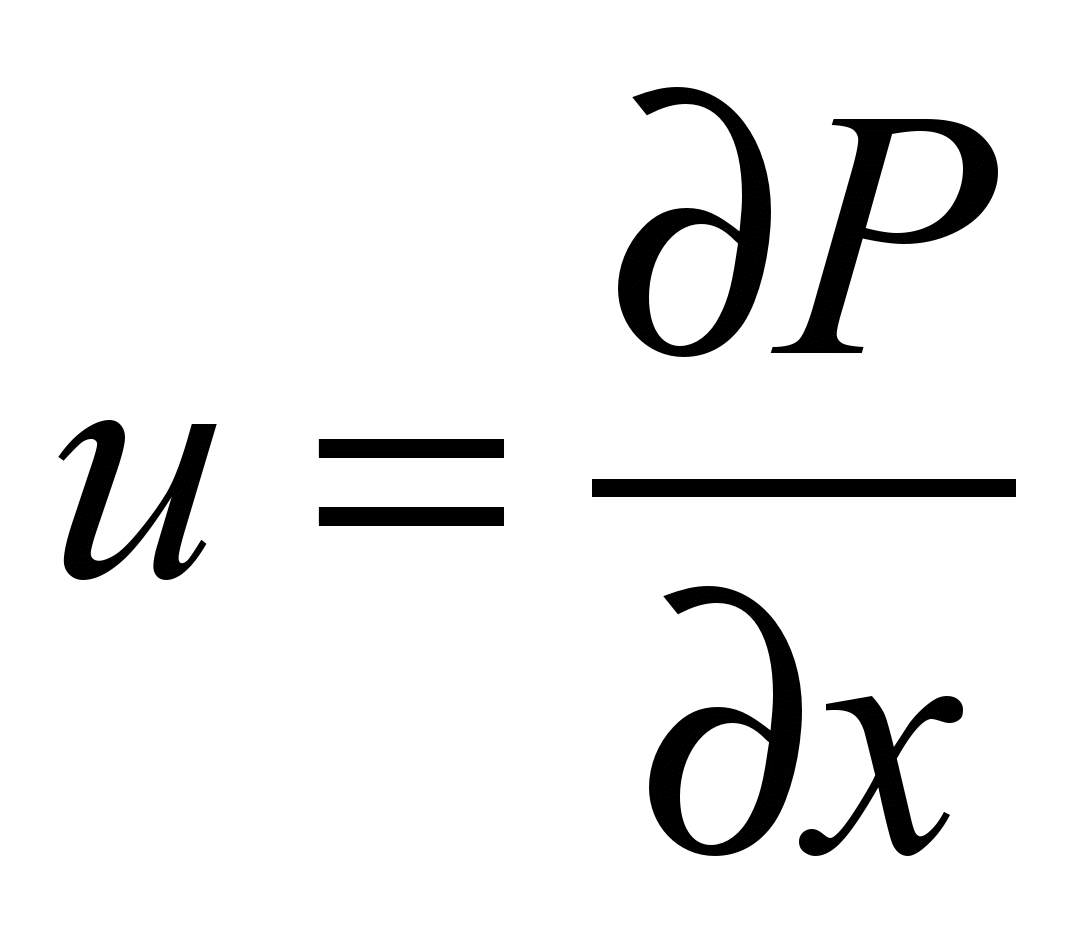 ,
,
 . (8)
. (8)
Boundary
conditions for equation (7) are [5]:
1.
At the inlet boundary
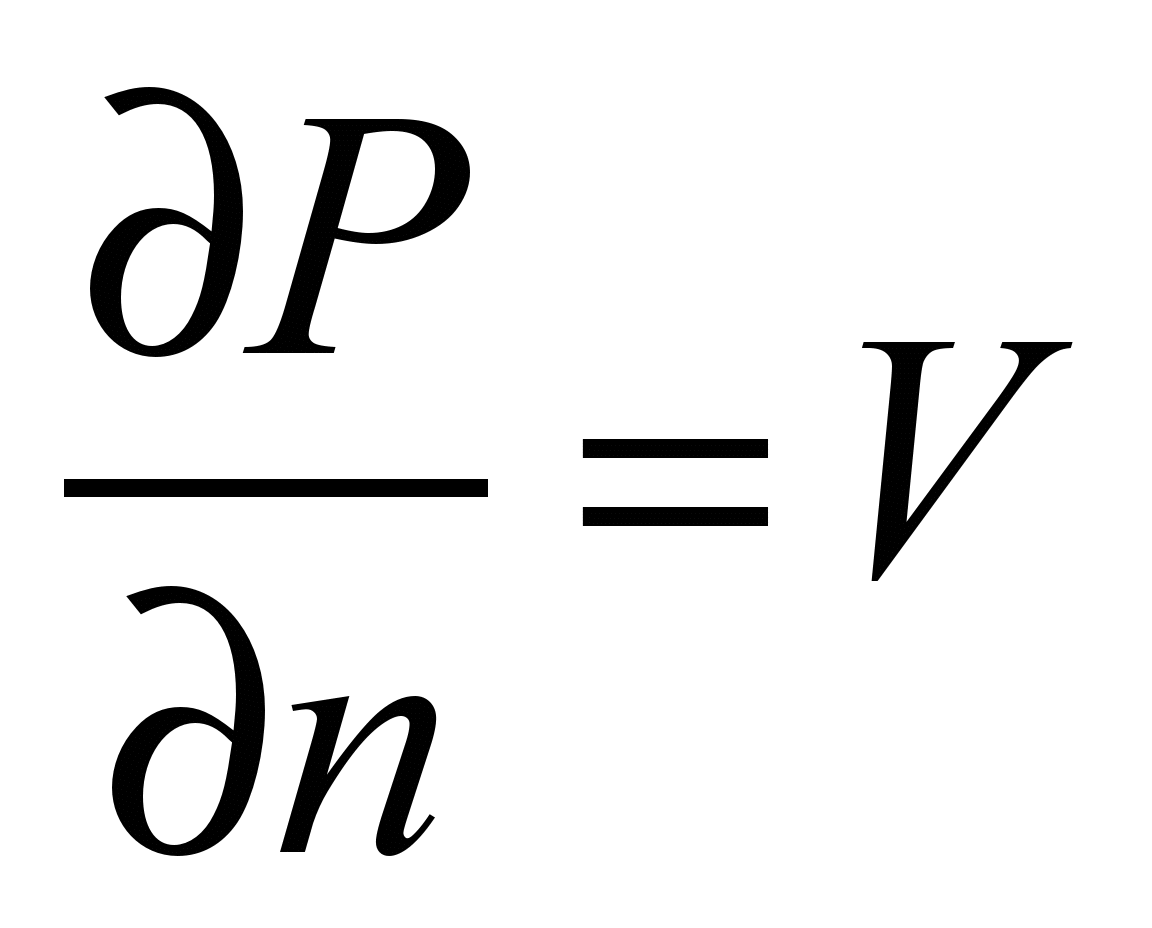 ,
where V
is known velocity.
,
where V
is known velocity.
2.
At the outlet boundary P=const.
3.
At the solid boundaries
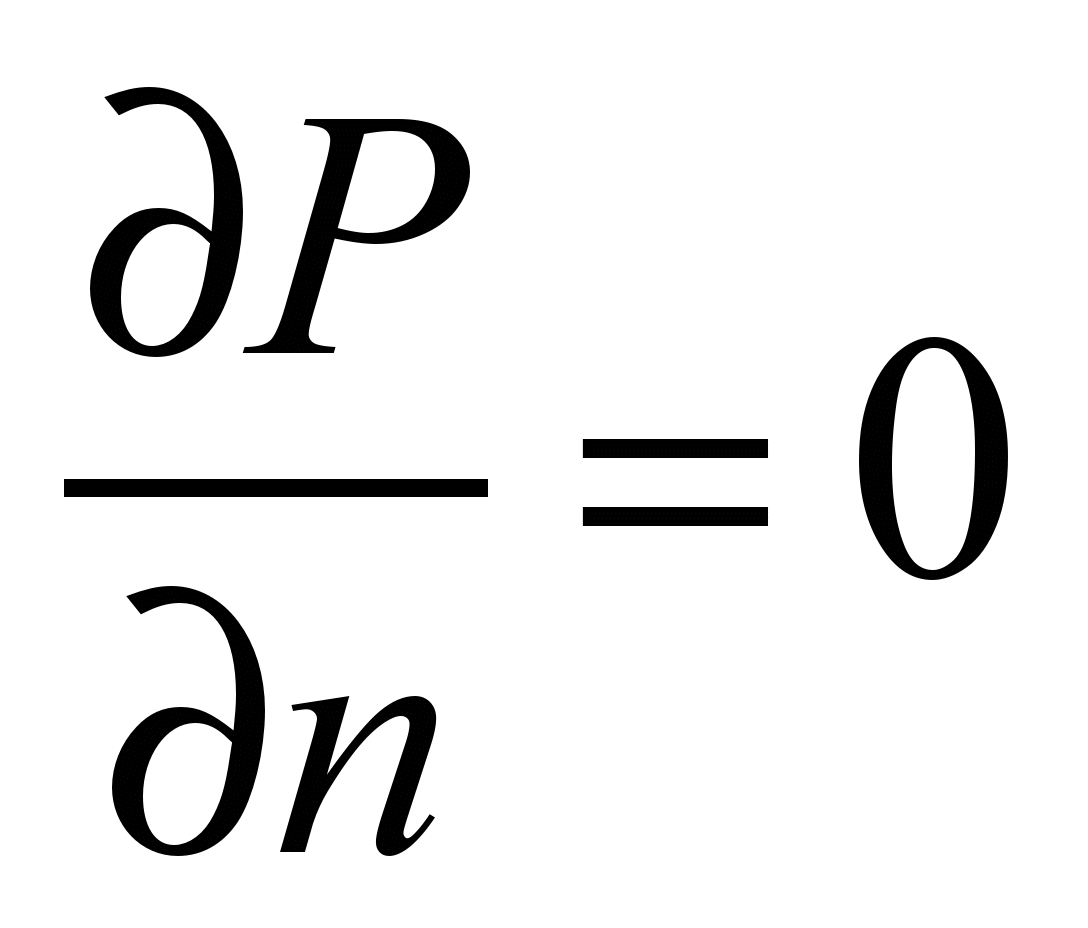 .
.
Numerical
model
To
perform numerical integration of governing equations rectangular
grid was used. Concentration of substrate, sludge and P were
determined in the centers of computational cells. Velocity
components u, v
were determined at the sides of computational cells.
To
solve equation (7) we used the difference scheme of «conditional
approximation». To use this scheme we wrote Eq. 5 in «unsteady»
form
 (9)
(9)
where
 is «fictitious»
time.
is «fictitious»
time.
It’s
known that for t solution of Eq.9 tends to the solution of Eq. 7.
We
split the process of Eq. 9 in two steps and difference equations at
each step are as follows [4]:
 , (10)
, (10)
 . (11)
. (11)
The
calculation on the basis of these formulas is complete if the
following condition is fulfilled:
 ,
,
where ε
is a small number; n is
iteration number.
Difference
scheme of splitting (10), (11) is implicit but unknown value of P
is calculated, at each step of splitting, using explicit formula of
«running
calculation».
That is very convenient for programming the difference formulae.
To
solve Eq. 9 it is necessary to set initial condition for fictitious
time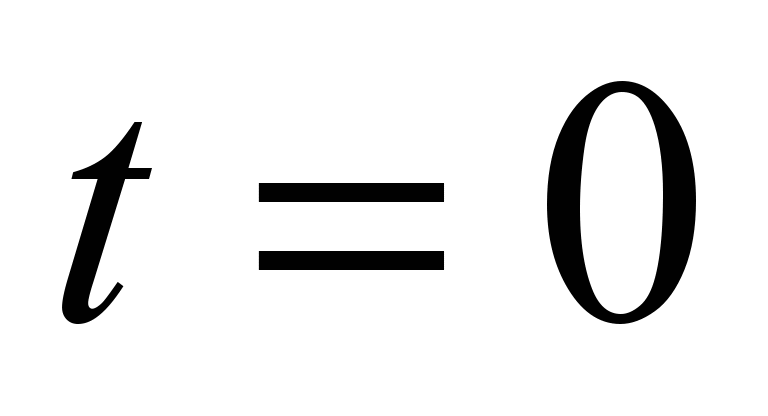 .
The initial condition is
.
The initial condition is
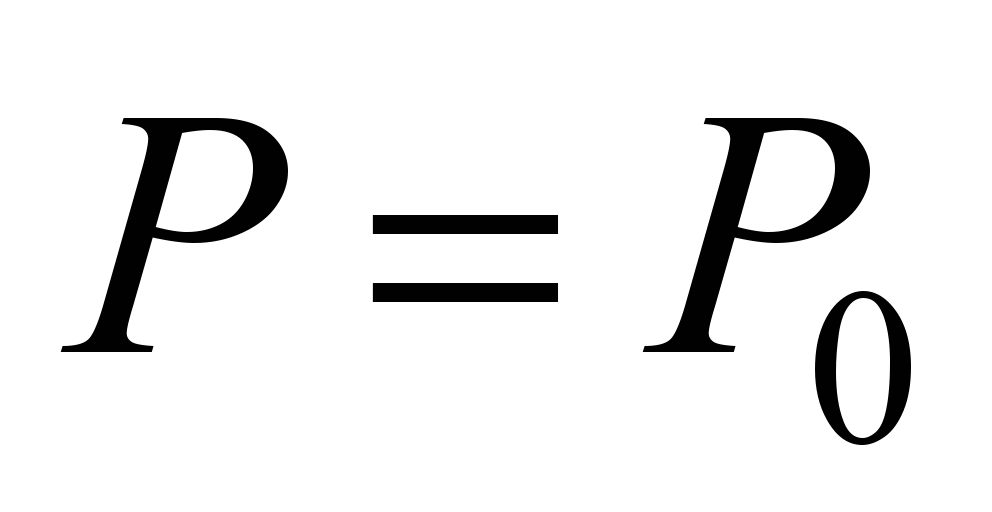 ,
,
where
 is known
value of potential in computational domain.
is known
value of potential in computational domain.
If
we know field of P in computational domain we can compute velocity
components at the side of computational cells
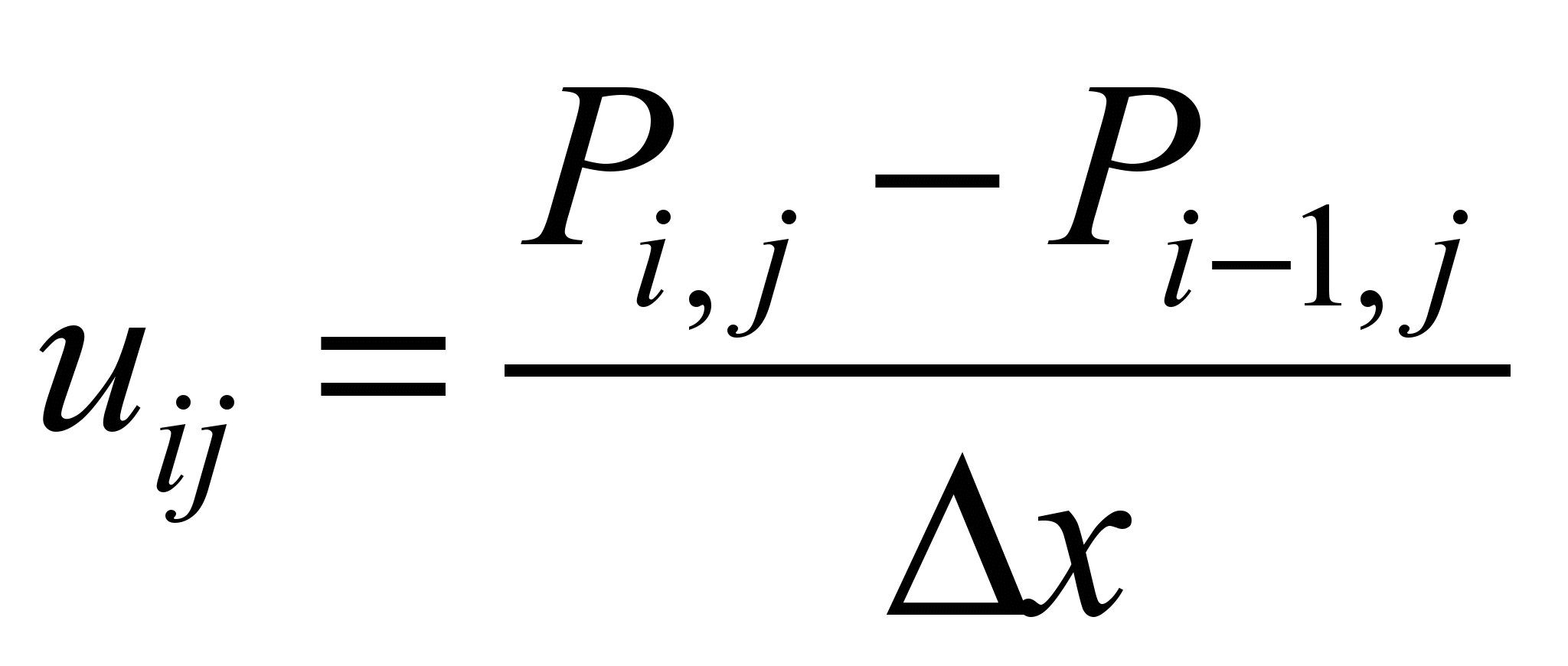 , (12)
, (12)
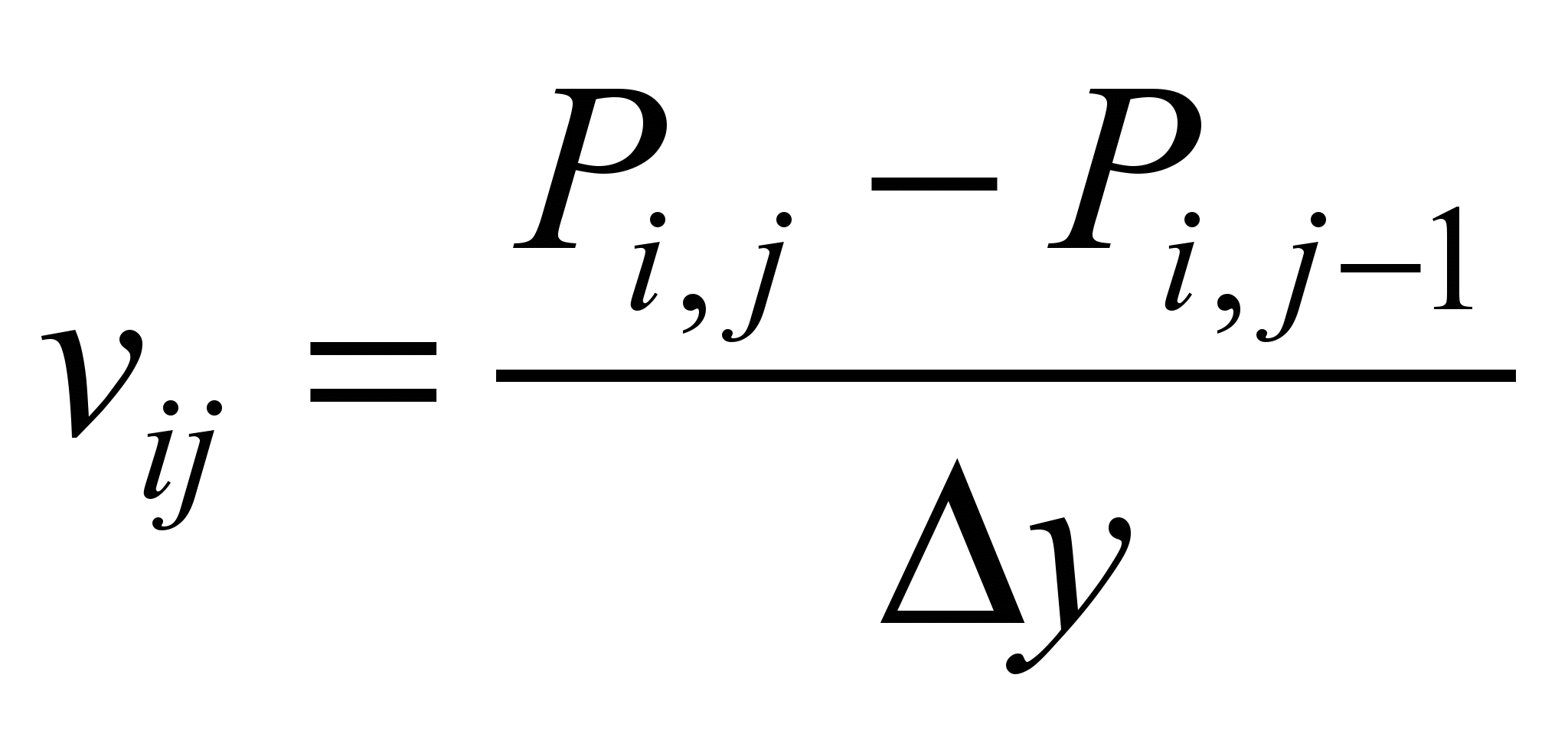 . (13)
. (13)
Main
features of the implicit difference scheme to solve numerically Eq.
1, 2 we consider only for equation of substrate transport because
Eq. 1 and 2 are similar from mathematical point of view. Before
numerical integration we split transport equation in two equations.
The scheme of splitting is as follows
 , (14)
, (14)
 . (15)
. (15)
From
the physical point of view, equation (14) takes into account
substrate movement along trajectories, equation (15) takes into
account the process of substrate diffusion in aeration tank. After
that splitting the approximation of equation (12) is carried out.
Time dependent derivative is approximated as follows:
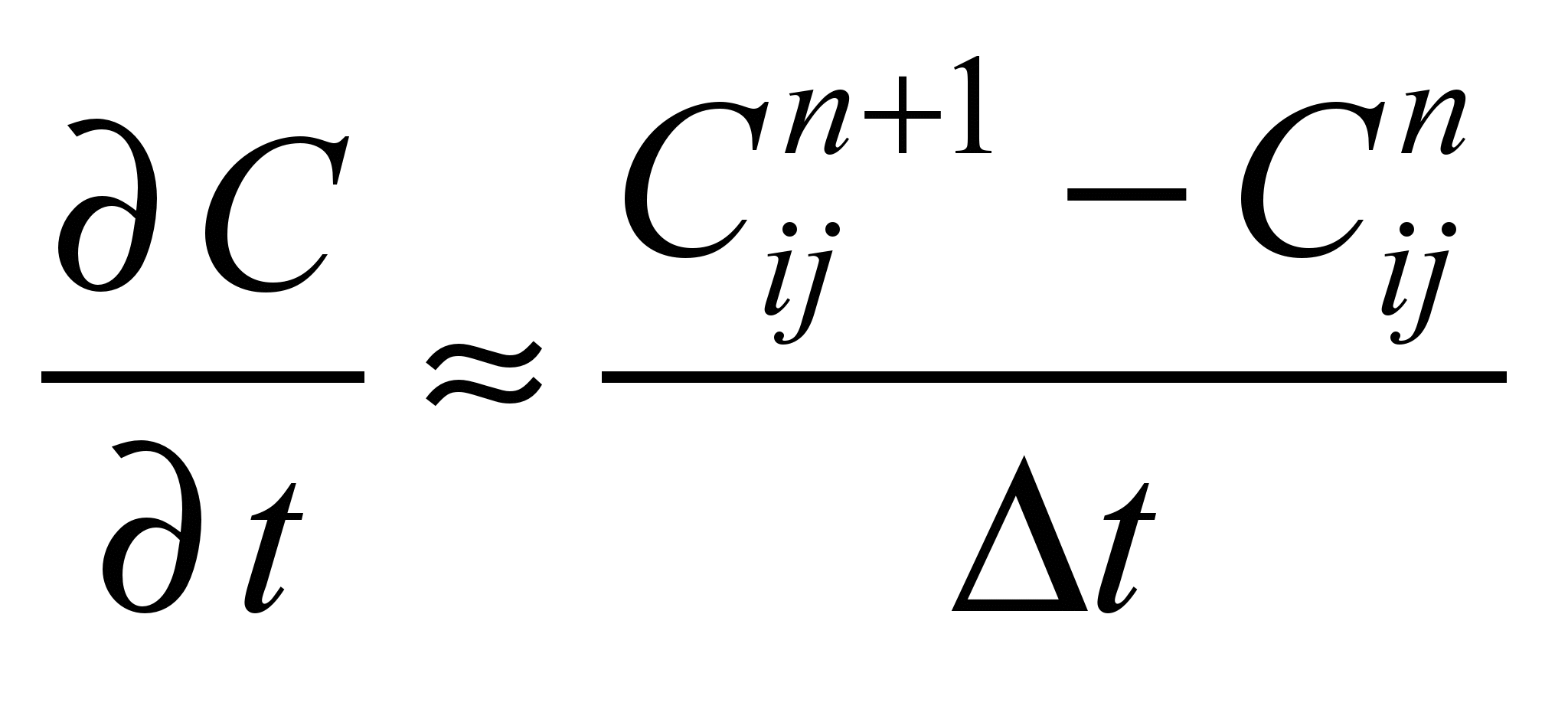 .
.
The
convective derivatives are represented as:


where
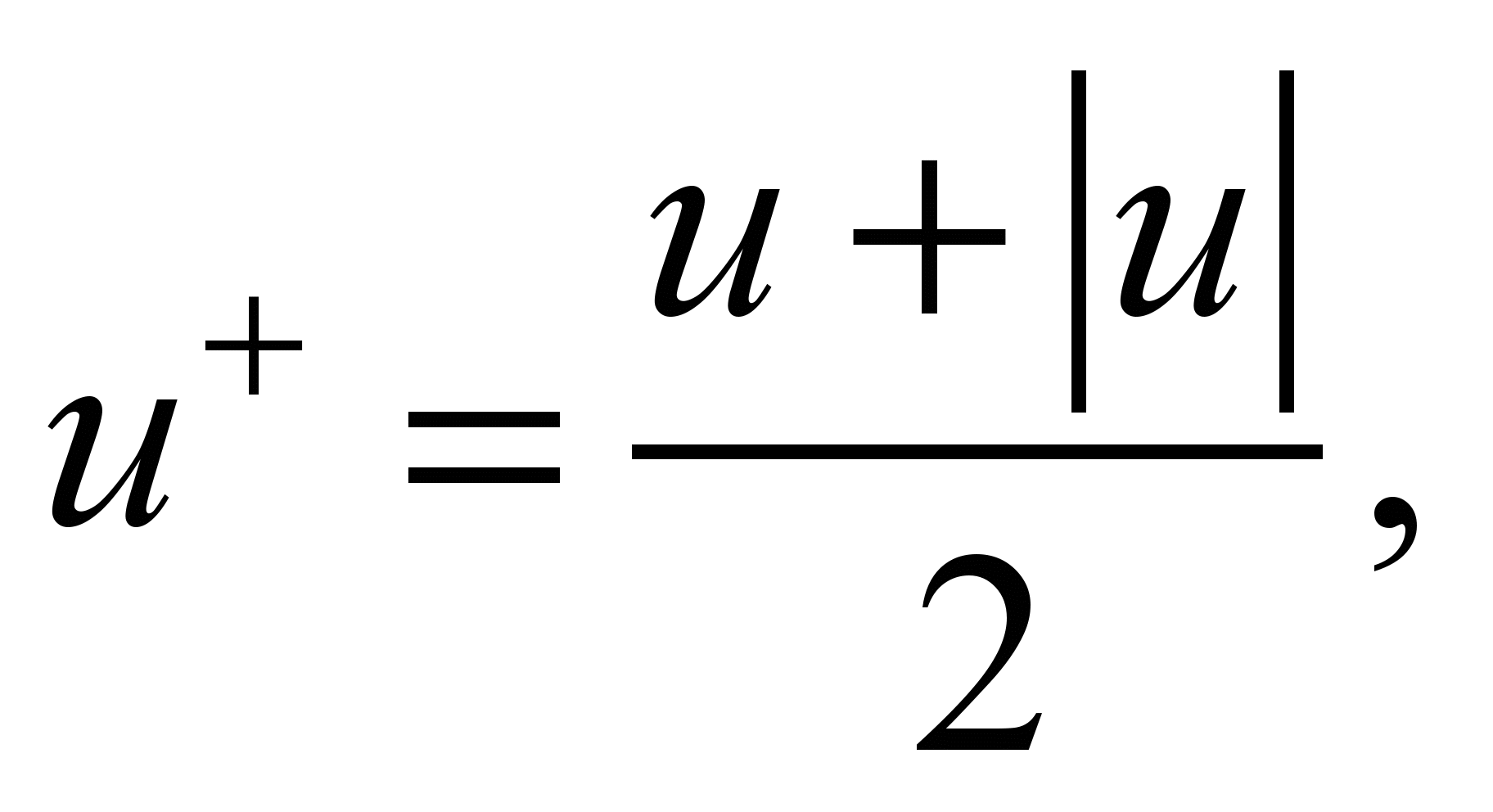
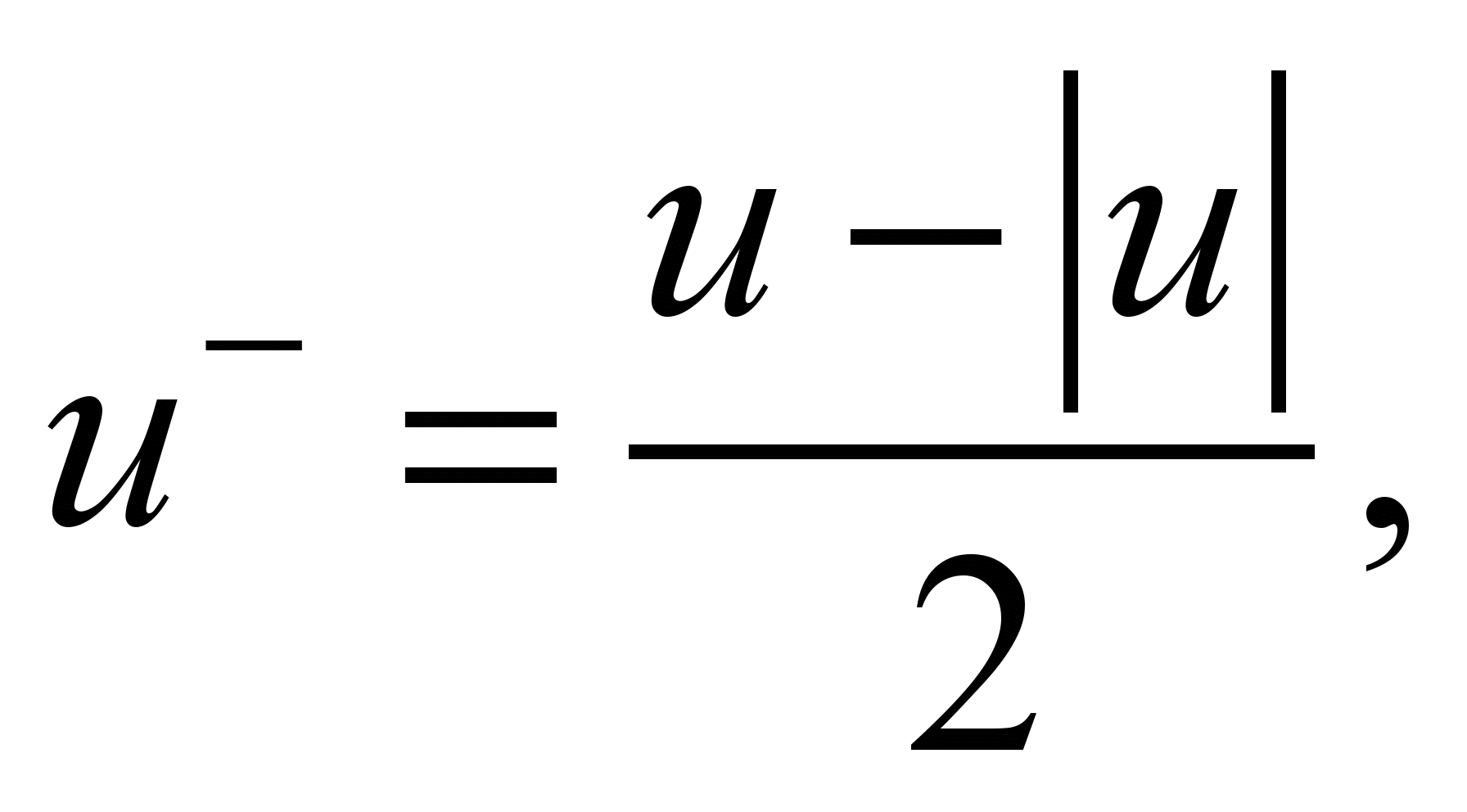
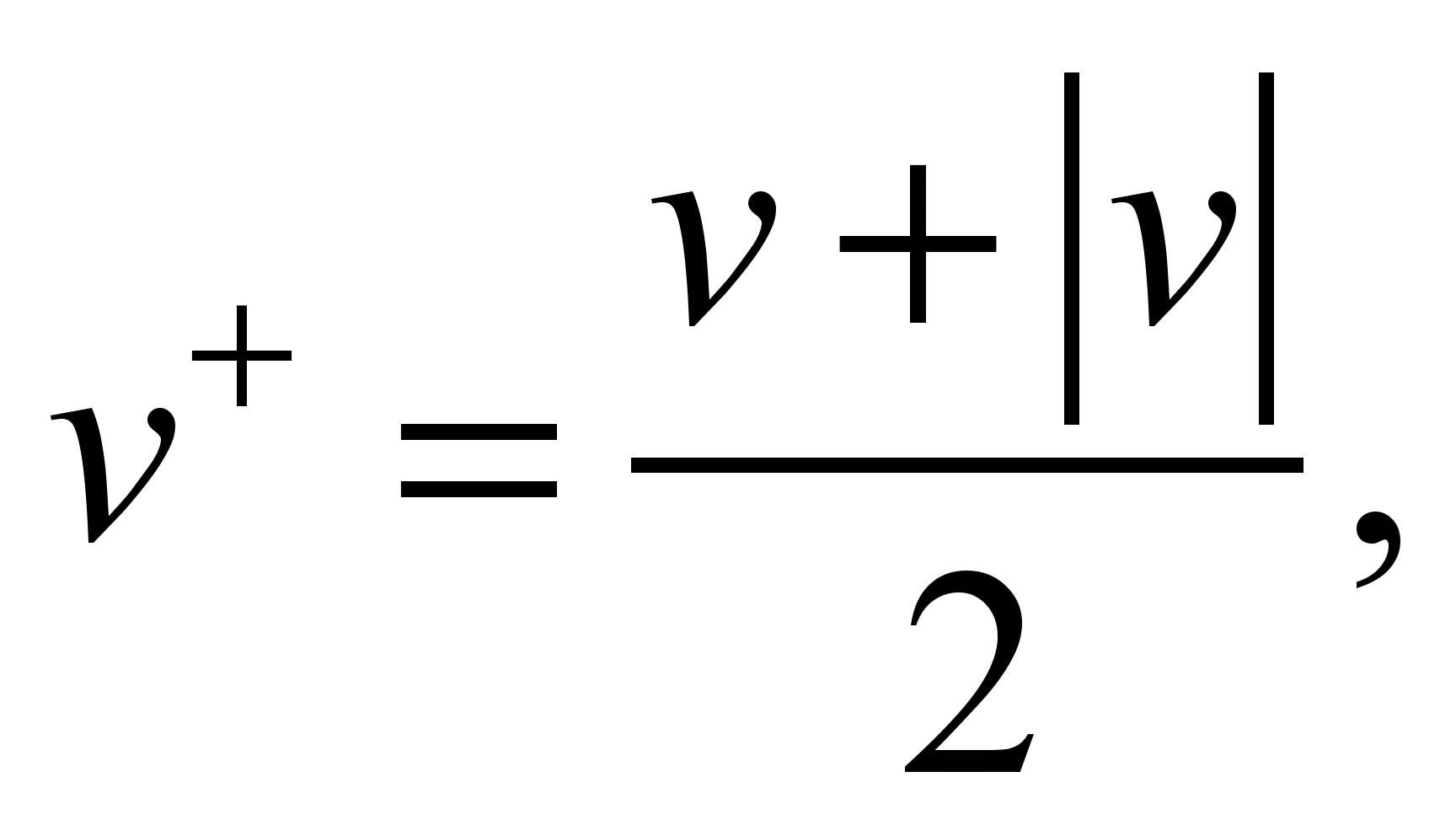
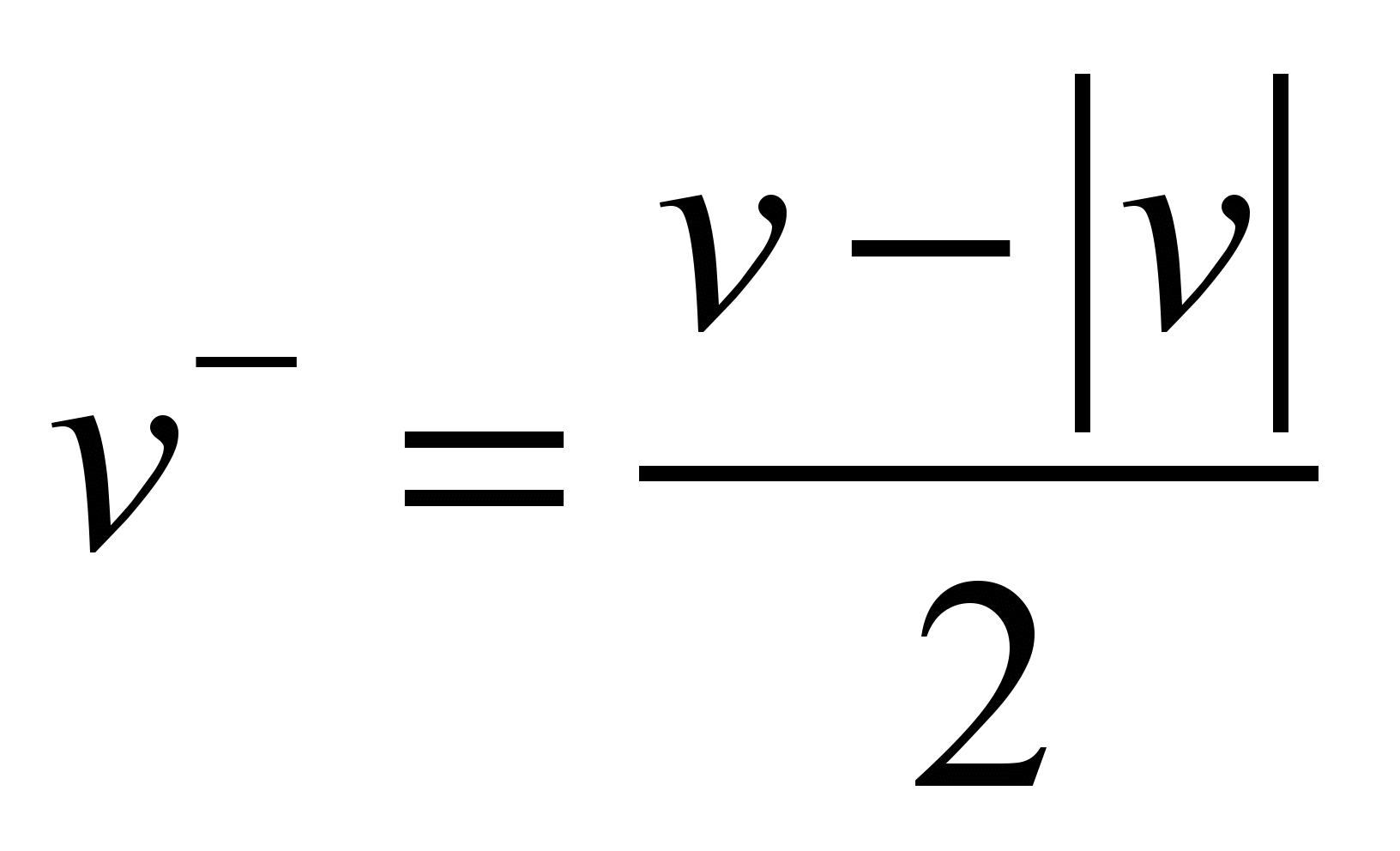 ,
,
 ,
,
 ,
,
 .
.
At
the next step we write the finite difference scheme of splitting:
 ; (16)
; (16)
 . (17)
. (17)
This
difference scheme is implicit and absolutely steady but unknown
concentration C is calcu-lated using the explicit formulae at each
step («method
of running calculation»).
Further,
Eq. (15) is numerically integrated using implicit difference scheme
(10), (11). To solve Eq. 3, 4 we used Eurler method. On the basis of
developed numerical model code «BIOTreat»
was developed. FORTRAN language was used to code the solution of
difference equations.
Description
of computational procedure
Numerical
solution of the whole problem is as follows:
–
Step 1:
we compute potential P in aeration tank (Eq. 8, 9)
–
Step 2:
we compute velocity components (Eq. 10, 11)
–
Step 3:
we compute biological process in ae-ration tank (Eq. 3, 4)
–
Step 4:
we compute substrate and sludge transport in aeration tank
(governing equations 1, 3; numerical equations 14, 15 (for C and S)
and Eq. 8, 9 written for C and S)
–
Step 5:
for the next time level t,
the computational procedure repeats from step 3.
Case
Study.
Developed code «BIOTrea»
was used to solve the following model
problem. The aeration tank is filled with sludge (concentration
S0=2)
and substrate (concentration C0=100)
at time t=0. All parameters of the problem are dimensionless. During
time period from t=0
till t=2
the inlet and outlet openings are
closed and no flow in the aeration tank. It means that for this time
period only biological treatment takes place and we solve only Eq.
3, 4 of the model. At time t=2
the inlet and outlet openings are open and the transport process
starts. At the inlet opening the substrate concentration is equal to
C0=100
and sludge concentration is equal to S0=2.
Also at this time five sources of sludge supply inside the aeration
tank starts to work with intensity Qi.
Position of these sources can be seen in Fig. 4 where the influence
of these sources results in local ‘deformation’ of concentration
field. This field has practically small concentration gradient in
aeration tank
everywhere except points where sources of sludge
supply are situated.
In
Fig. 3 we present sludge and substrate concentration change near the
outlet opening of the aeration tank (point A in Fig.4). From Fig. 3
we can see that the process of biological treatment accelerates from
t=2 and concentration of sludge at the outlet opening increases with
time.
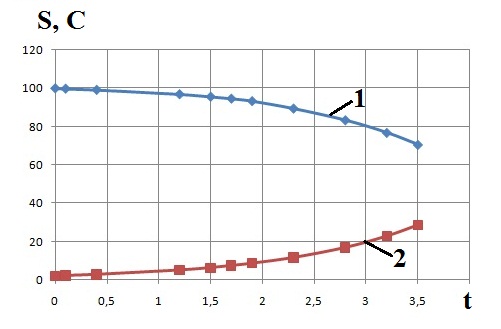
Fig.
3. Sludge and substrate concentration
change
near the outlet opening:
1
– substrate concentration; 2
– sludge concentration
In
Fig. 4 the concentration field of sludge for time step t=4 is shown.
It is well seen the zones of sludge sources influences. These zones
have form of circles.
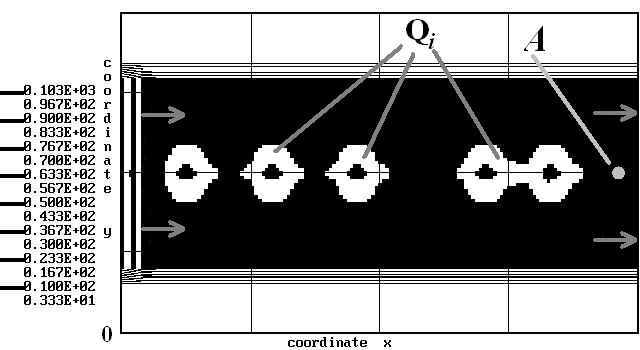
Fig.
4. Field of sludge concentration inside
the
aeration tank, t=4:
1
– position of sludge supply sources
Findings
Quick
computing numerical model was deve-loped to simulate the wastewater
treatment in aeration tank. The model does not take much time
because the fluid dynamics process is simulated on the basis of
potential flow model.
Originality
and practical value
A
new numerical model to predict the output parameters of aeration
tank was developed. The model is based on the 2-D transport
equations of substrate and sludge and simplified equations of
biological treatment. The developed model takes into account
geometrical form of aeration tank. The model can be useful in
aeration tanks design.
Conclusions
The
article contains results of numerical model development for
wastewater treatment in «vitesnitel» aeration tank (aeration tank
of displacement type). To simulate the process of biological
treatment 2-D transport equations of substrate and sludge are used
together with simplified models of biological treatment. The future
work in this field will be connected with development of fluid
dynamics model which takes into account oxygen transfer in the
aeration tank.
LIST
OF
REFERENCE
LINKS
Беляев,
Н. Н. Математическое моделирование
массопереноса в горизонтальных
отстойниках /
Н. Н. Беляев, В. А.
Козачина. – Днепропетровск : Акцент
ПП, 2015. – 115 с.
Беляев,
Н. Н. Математическое моделирование
массопереноса в отстойниках систем
водоотведения /
Н. Н. Беляев, Е. К.
Нагорная. – Днепропетровск : Новая
идеология, 2012. – 112 с.
Горносталь,
С. А.
Исследование
зависимости концентрации загрязнений
в очищенной воде на выходе из аэротенка
в процессе биологической очистки
/ С. А.
Горносталь, Ю. В. Уваров //
Проблеми надзвичайних ситуацій
: зб.
наук. пр. –
Харків,
2011. – Вип. 14. – С.
65–69.
Козачек,
А. В. Исследование математической
модели процесса аэробной очистки
сточных вод как стадия оценки качества
окружающей водной среды / А. В. Козачек,
И. М. Авдашин, В. А. Лузгачев // Вестн.
Тамбов. техн. ун-та.
Серия: Естественные и технические
науки. – 2014. – Т. 19, вып. 5. –
С. 1683–1685.
Колобанов,
С.
К.
Проектирование
очистных сооружений канализации
/ С.
К. Колобанов,
А.
В. Ершов,
М.
Е.
Кигель.
– Киев
: Будівельник,
1997. – 224 с.
Олійник,
О. Я. Моделювання очистки стічних вод
від органічних забруднень в
біореакторах-аеротенках зі зваженим
(вільно плаваючим) і закріпленим
біоценозом / О. Я. Олійник, Т. С. Айрапетян
// Доп. нац. акад. наук України. – 2015. –
№ 5. – С. 55–60.
doi:
10.15407/dopovidi2015.05.055.
Очистка
производственных сточных вод в
аэротенках / Я. А. Карелин, Д. Д. Жуков,
В. Н. Журов,
Б. Н. Репин. – Москва :
Стройиздат, 1973. – 223 с.
Святенко,
А. І. Важливість урахування особливостей
біологічного очищення в аеротенках
для поліпшення показників їх роботи
/ А. І. Святенко, Л. М. Корніенко //
Екологічна безпека. – 2009. – № 4 (8). –
С. 93–96.
Теоретический
анализ процессов осаждения
в системах
биологической очистки сточных вод /
А.
Я.
Олейник,
Ю.
И.
Калугин,
Н.
Г. Степовая,
С.
М.
Зябликов
// Прикладна
гідромеханіка.
–
2004.
– Т.
6
(78),
№ 4.
– С. 62–67.
Biliaiev,
M. M. Numerical determination of horizontal settlers performance /
M. M. Biliaiev, V. A. Kozachyna
// Наука та прогрес транспорту. – 2015.
–
№ 4 (58). – P.
34–43. doi:
10.15802/STP2015/49201.
Foat,
T. G. Investigating a selection of mixing times for transient
pollutants in mechanically ventilated, isothermal rooms using
automated computational fluid dynamics analysis / T. G. Foat, J.
Nally, S. T. Parker // Building and Environment. – 2017. – Vol.
118. – Р.
313–322. doi: 10.1016/j.buildenv.2017.01.011.
Hadad,
H. Numerical Simulation of the Flow Pattern in the Aeration Tank of
Sewage Treatment System by the Activated Sludge Process Using
Fluent Program / H. Hadad, J. Ghaderi // Biological Forum. –
2015. – Vol. 7 (1). – P. 382–393.
Ilie,
M. Modeling and simulation of Organic Matter Biodegradation
Processes in Aeration Tanks with Activated Sludge / M. Ilie, D. N.
Robescu, G. Chita // Revista de chimie (Bucureti-România). –
2009. – Vol. 60,
Nо.
5. – P. 529–532.
Kozachyna,
V. A. Investigation of admixture sedimentation in the horizontal
settler / V. A. Kozachyna
// Наука та прогрес транспорту. – 2016.
–
№ 4 (64).
– P.
7–14.
doi:
10.15802/stp2016/77827.
Mocanu,
C. R. Numerical simulations of wastewater treatment aeration
processes / C. R. Mocanu,
R. Mihailescu // U.P.B. Scientific
Bulletin. Series D. – 2012. – Vol. 74. – Iss. 2. – P.
191–198.
Modeling
based decision for smart city environmental alert system for
accidental air pollution / Sahar Masmoudi, Amjad Kallel, Dalila
Taieb, Abdenaceur Kachouri // 2017
Intern. Conf. on Smart, Monitored and Controlled Cities (SM2C) :
Conf. Paper (February, 17–19,
2017). – Kerkennah, Tunisia, 2017. – Р.
96–100.
doi:
10.1109/SM2C.2017.8071826.
Ranking
surface soil pollution potential of chemicals from accidental
release by using two indicators calculated with a multimedia model
(SoilPCA) / Ki-Eun Kim, Ja Eun Jung, Yunah Lee, Dong Soo Lee //
Ecological Indicators. – 2018. –Vol. 85. – Р.
664–673. doi: 10.1016/j.ecolind.2017.11.010.
М. М. БІЛЯЄВ1*, М. В. ЛЕМЕШ2*
1*Каф. «Гідравліка
та водопостачання», Дніпропетровський
національний
університет залізничного
транспорту імені академіка В. Лазаряна,
вул. Лазаряна, 2, Дніпро,
Україна, 49010, тел. +38 (056) 273 15
09,
ел. пошта water.supply.treatment@gmail.com
,
ORCID 0000-0002-1531-7882
2*Каф. «Гідравліка
та водопостачання», Дніпропетровський
національний
університет залізничного
транспорту імені академіка В. Лазаряна,
вул. Лазаряна, 2, Дніпро,
Україна, 49010, тел. +38 (056) 273 15
09,
ел. пошта water.supply.treatment@gmail.com
,
ORCID 0000-0002-1230-8040
МОДЕЛЮВАННЯ БІОЛОГІЧНОЇ
ОЧИСТКИ
стічних вод НА ОСНОВІ ШВИДКОДІЮЧОЇ
чисельнОЇ моделІ
Мета.
Наукова робота передбачає розробку
швидкодіючої чисельної моделі для
прогнозування вихідних параметрів
аеротенка. Чисельну модель можна
використовувати для прогнозування
ефективності аеротенка при різних
режимах роботи. Методика.
Для моделювання процесу
біологічної очистки стічних вод в
аеротенках були розроблені чисельні
моделі. Поле потоку в аеротенку
відтворюється на основі моделі
потенційної течії. 2-D рівняння масопереносу
використовуються для моделювання
розсіювання субстрату і мулу. Для
моделювання процесу біологічної обробки
застосовується спрощена модель. Для
чисельного інтегрування рівнянь
переносу вживалася неявна різницева
схема. Різницева схема побудована для
розщеплення рівнянь переносу. Розщеплення
рівняння переносу здійснюється на два
рівняння та виконується на диференціальному
рівні. Перше рівняння розщеплення
враховує рух мулу або субстрату по
траєкторіях, а друге – дифузний процес
перенесення домішки і мулу. Для вирішення
рівнянь розщеплення використовувалася
неявна різницева схема. Для чисельного
інтегрування рівняння потенційної
течії застосовувалася неявна схема
умовного наближення. На основі побудованої
чисельної моделі був виконаний
комп'ютерний експеримент для дослідження
процесу біологічної очистки в аеротенку.
Результати.
Розроблена чисельна модель дозволяє
швидко моделювати процес біологічної
очистки в аеротенку. Модель може
використовуватися для оцінки ефективності
роботи аеротенків при різних режимах
роботи. Розроблена модель враховує
геометричну форму аеротенка. Наукова
новизна. Розроблено
чисельну модель, що враховує геометричну
форму аеротенка та процес динаміки
рідини, а також процес руху субстрату
і мулу в аеротенку. Практична
значимість. Запропоновано
ефективну чисельну модель класу
«diagnostic models» для швидкого розрахунку
процесу біологічної очистки в аеротенку.
Ключові слова: біологічна
очистка; чисельне моделювання, аеротенк
Н. Н. БЕЛЯЕВ1*, М. В. ЛЕМЕШ2*
1*Каф.
«Гидравлика и водоснабжение»,
Днепропетровский национальный
университет железнодорожного транспорта
имени академика В. Лазаряна,
ул. Лазаряна,
2, Днипро, Украина, 49010, тел. +38 (056)
273 15
09,
эл. почта water.supply.treatment@gmail.com
, ORCID 0000-0002-1531-7882
2*Каф.
«Гидравлика и водоснабжение»,
Днепропетровский национальный
университет железнодорожного транспорта
имени академика В. Лазаряна,
ул. Лазаряна,
2, Днипро, Украина, 49010, тел. +38 (056)
273 15
09,
эл. почта water.supply.treatment@gmail.com
, ORCID 0000-0002-1230-8040
МОДЕЛИРОВАНИЕ БИОЛОГИЧЕСКОЙ
очистки СТОЧНых ВОД НА ОСНОВЕ
БЫСТРОДЕЙСТВУЮЩЕЙ ЧИСЛЕННОЙ
МОДЕЛИ
Цель.
Научная работа предполагает разработку
быстродействующей численной модели
для прогнозирования выходных параметров
аэротенка. Численную модель можно
использовать для прогнозирования
эффективности аэротенка при различных
режимах работы. Методика.
Для моделирования процесса биологической
очистки сточных вод в аэротенке были
разработаны численные модели. Поле
потока в аеротенке воспроизводится на
основе модели потенциального течения.
2-D уравнения массопереноса
используются для моделирования
рассеивания субстрата и ила. Для
моделирования процесса биологической
очистки используется упрощенная модель.
Для численного интегрирования уравнений
переноса применялась неявная разностная
схема. Разностная схема построена для
расщепления уравнений переноса.
Расщепление уравнения переноса
осуществляется на два уравнения и
выполняется на дифференциальном уровне.
Первое уравнение расщепления учитывает
движение ила или субстрата по траекториям,
а второе – диффузионный процесс переноса
примеси и ила. Для решения уравнений
расщепления использовалась неявная
разностная схема. Для численного
интегрирования уравнения потенциального
течения применялась неявная схема
условного приближения. На основе
построенной численной модели был
выполнен компьютерный эксперимент для
исследования процесса биологической
очистки в аэротенке.
Результаты. Разработанная
быстродействующая численная модель
позволяет быстро моделировать процесс
биологической очистки в аэротенке.
Модель может использоваться для оценки
эффективности работы аеротенка при
разных режимах работы. Разработанная
модель учитывает геометрическую форму
аэротенка. Научная
новизна. Разработана
численная модель, учитывающая
геометрическую форму аэротенка и
процесс динамики жидкости; а также
процесс движения субстрата и ила в
аэротенке и процесс биологической
очистки. Практическая
значимость. Предложена
эффективная численная модель класса
«diagnostic
models» для
быстрого расчета процесса биологической
очистки в аэротенке.
Ключевые слова: биологическая
очистка; численное моделирование;
аэротенк
REFERENCES
Biliaiev,
N. N., & Kozachina, V. A. (2015). Matematicheskoe
modelirovanie massoperenosa v gorizontalnykh otstoynikakh.
Dnepropetrovsk: Aktsent PP. (In Russian)
Biliaiev,
N. N., & Nagornaya, E. K. (2012). Matematicheskoe
modelirovanie massoperenosa v otstoynikakh sistem vodootvedeniya.
Dnepropetrovsk: Novaya ideologiya. (In Russian)
Gornostal,
S. A., & Uvarov, Yu. V. (2011). Issledovanie zavisimosti
kontsentratsii zagryazneniy v ochishchennoy vode na vykhode iz
aerotenka v protsesse biologicheskoy ochistki. Problemy
nadzvychainykh sytuatsіi: zbіrnyk naukovykh prats, 14,
65-69. (In Russian)
Kozachek,
A. V., Avdashin, I. M., & Luzgachev, V. A. (2014). Issledovanie
matematicheskoy modeli protsessa aerobnoy ochistki stochnykh vod
kak stadiya otsenki kachestva okruzhayushchey vodnoy sredy. Vestnik
Tambovskogo tekhnicheskogo universiteta. Seriya: Yestestvennye i
tekhnicheskie nauki, 19(5),
1683–1685. (In Russian)
Kolobanov,
S. K., Yershov, A. V., & Kigel, M. Ye. (1997). Proektirovanie
ochistnykh sooruzheniy kanalizatsii.
Kiev: Budіvelnik. (In Russian)
Oliinyk,
O. Ya., & Airapetyan, T. S. (2015). The modeling of the
clearance of waste waters from organic pollutions in
bioreactors-aerotanks with suspended (free flow) and fixed
biocenoses. Dopovidi
natsionalnoi aka-demii nauk Ukrainy, 5, 55-60.
doi: 10.15407/dopovidi2015.05.055
(In Ukranian)
Karelin,
Ya. A., Zhukov, D. D., Zhurov, V. N., & Repin, B. N. (1973).
Ochistka
proizvodstvennykh stochnykh vod v aerotenkakh. Moscow:
Stroyizdat. (In Russian)
Sviatenko,
A. I., & Kornienko, L. M. (2009). Vazhlyvist urakhuvannia
osoblyvostei biolohichnoho ochyshchennia v aerotenkakh dlia
polipshennia pokaznykiv yikh roboty. Ekolohichna
bezpeka, 4(8),
93–96. (In Ukranian)
Oleynik,
Ya. A., Kalugin, Yu. I., Stepovaya, N. G., & Zyablikov, S. M.
(2004). Teoreticheskiy analiz protsessov osazhdeniya v sistemakh
biologicheskoy ochistki stochnykh vod. Prikladna
gіdromekhanіka, 6(78), 4,
62-67. (In Russian)
Biliaiev,
M. M., & Kozachyna, V. A. (2015). Numerical determination of
horizontal settlers performance. Science
and Transport Progress, 4(58),
34-43. doi: 10.15802/STP2015/49201. (In English)
Foat,
T. G., Nally, J., & Parker, S. T. (2017). Investigating a
selection of mixing times for transient pollutants in mechanically
ventilated, isothermal rooms using automated computational fluid
dynamics analysis. Building
and Environment, 118,
313-322. doi: dx.doi.org/10.1016/j.buildenv.2017.01.011. (In
English)
Hadad,
H., & Ghaderi, J. (2015). Numerical Simulation of the Flow
Pattern in the Aeration Tank of Sewage Treatment System by the
Activated Sludge Process Using Fluent Program. Biological
Forum, 7(1),
382-393. (In English)
Ilie,
M., Robescu, D. N., & Chita, G. (2009). Modeling and simulation
of Organic Matter Biodegradation Processes in Aeration Tanks with
Activated Sludge. Revista
de chimie (Bucureti-România), 60(5),
529-532. (In English)
Kozachyna,
V. A. (2016). Investigation of admixture sedimentation in the
horizontal settler. Science
and Transport Progress, 4(64),
7-14. doi: 10.15802/stp2016/77827. (In English)
Mocanu,
C. R., & Mihailescu, R. (2012). Numerical simulations of
wastewater treatment aeration processes. U.P.B.
Scientific Bulletin, Series D, 74(2),
191-198. (In English)
Masmoudi,
S., Kallel, A., Taieb, D., & Kachouri, A. (2017). Modeling
based decision for smart city environmental alert system for
accidental air pollution.
International
Conference on Smart, Monitored and Controlled Cities (SM2C),
Kerkennah, Tunisia, February, 17-19,
96-100, doi:
10.1109/SM2C.2017.8071826.
(In English)
Ki-Eun
Kim, Ja Eun Jung, Yunah Lee, & Dong Soo Lee (2018). Ranking
surface soil pollution potential of chemicals from accidental
release by using two indicators calculated with a multimedia model
(SoilPCA). Ecological
Indicators, 85,
664-673. doi: //doi.org/10.1016/j.ecolind.2017.11.010. (In English)
Prof.
S. A. Pichuhov, Dr. Sc. (Phys.-Math.) (Ukraine) recommended this
article to be published
Received:
Oct. 04, 2017
Accessed:
Jan. 05, 2017
(1)
– is the averaged concentration of substrate; H – is the depth
– is the averaged concentration of
sludge for biological treatment;
– are the flow velocity components in x,
y direction respectively;
– are the
coefficients of turbulent diffusion in x,
y direction respectively;
– is time.
(3)
are known concentrations of substrate and sludge respectively.
(4)
are concentrations at the last computational cell;
are concentrations at the previous computational cell.
is normal vector to the boundary.
,
is
are known concentrations of substrate and sludge respectively in
computational domain.
, (5)
(6)
is biomass growth rate;
is biomass yield factor.
(7)
,
. (8)
,
where V
is known velocity.
.
(9)
is «fictitious»
time.
, (10)
. (11)
,
.
The initial condition is
,
is known
value of potential in computational domain.
, (12)
. (13)
, (14)
. (15)
.
,
,
,
.
; (16)
. (17)